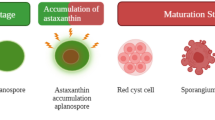Abstract
The adaptive response of the fungus Blakeslea trispora to the oxidative stress induced by iron ions during carotene production in shake flask culture was investigated. The culture response to oxidative stress was studied by measuring the specific activities of catalase (CAT) and superoxide dismutase (SOD). The addition of 1.0 mM of FeCl3 to the medium was associated with a mild oxidative stress as evidenced by remarkable increase of the specific activities of SOD and CAT. On the other hand, the addition 5.0 mM of FeCl3 caused a strong oxidative stress resulting in a drastic decrease in carotene concentration. The oxidative stress in B. trispora changed the composition of the carotenes and caused a significant increase of γ-carotene ratio. The highest concentration of carotenes (115.0 ± 3.5 mg/g dry biomass) was obtained in the basal medium without the addition of FeCl3 after 8 days of fermentation. In this case, the carotenes consisted of β-carotene (46.3 %), γ-carotene (40.1 %), and lycopene (13.6 %). The addition of 1.0 mM of FeCl3 into the medium did not change the concentration of carotenes. But, the composition of carotenes was changed with a drastic increase of γ-carotene ratio (61.6 %) and a decrease in β-carotene and lycopene ratio (31.2 and 7.2 %, respectively).





Similar content being viewed by others
References
Varzakakou, M., Roukas, T., Kotzekidou, P., & Giamoustaris, A. (2010). Food Biotechnology, 24, 197–214.
Ribeiro, B. D., Barreto, D. W., & Coelho, M. A. Z. (2011). Food and Bioprocess Technology, 4, 693–701.
Wang, J. F., Liu, X. J., Liu, R. S., Li, H. M., & Tang, Y. J. (2012). Bioprocess and Biosystems Engineering, 35, 553–564.
Liu, X. J., Liu, R. S., Li, H. M., & Tang, Y. J. (2012). Bioprocess and Biosystems Engineering, 35, 739–749.
Angelova, M. B., Pashova, S. B., Spasova, B. K., Vassilev, S. V., & Slokoska, L. S. (2005). Mycological Research, 109, 150–158.
Faine, L. A., Rodrigues, H. G., Galhardi, C. M., Ebaid, G. M. X., Diniz, Y. S., Fernandes, A. A. H., et al. (2006). Experimental and Toxicologic Pathology, 57, 221–226.
Nanou, K., Roukas, T., & Kotzekidou, P. (2007). Applied Microbiology and Biotechnology, 74, 447–453.
Jamieson, D. J. (1998). Yeast, 14, 1511–1527.
Gessler, N. N., Aver’yanov, A. A., & Belozerskaya, T. A. (2007). Biochemistry (Moscow), 72, 1091–1109.
Bhosale, P. (2004). Applied Microbiology and Biotechnology, 63, 351–361.
Jeong, J. C., Lee, I. Y., Kim, S. W., & Park, Y. H. (1999). Biotechnology Letters, 21, 683–686.
Choudhari, S. M., Ananthanarayan, L., & Singhal, R. S. (2008). Bioresource Technology, 99, 3166–3173.
Mantzouridou, F., Roukas, T., & Achatz, B. (2005). Enzyme and Microbial Technology, 37, 687–694.
Xu, F., Yuan, Q. P., & Zhu, Y. (2007). Process Biochemistry, 42, 289–293.
Filotheou, A., Nanou, K., Papaioannou, E., Roukas, T., Kotzekidou, P., & Liakopoulou-Kyriakides, M. (2012). Food and Bioprocess Technology, 5, 1189–1196.
Nanou, K., & Roukas, T. (2010). Applied Biochemistry and Biotechnology, 160, 2415–2423.
Nanou, K., & Roukas, T. (2011). Bioresource Technology, 102, 8159–8164.
Nanou, K., Roukas, T., & Papadakis, E. (2011). Biochemical Engineering Journal, 54, 172–177.
Schacterle, G., & Pollack, R. (1973). Analytical Biochemistry, 51, 654–655.
Ninet, L., & Renaut, J. (1979). In H. J. Peppler & D. Perlman (Eds.), Microbial technology (2nd ed., Vol. 1, pp. 529–544). New York: Academic.
Govind, N. S., Amin, A. R., & Modi, V. V. (1982). Phytochemistry, 21, 1043–1044.
Gessler, N. N., Sokolov, A. V., Bykhovsky, V. Y., & Belozerskaya, T. A. (2002). Applied Biochemistry and Microbiology, 38, 205–209.
Miller, R. A., & Britigan, B. E. (1997). Clinical Microbiology Reviews, 10, 1–18.
Philpott, C. C. (2006). Biochimica et Biophysica Acta, 1763, 636–645.
Yen, G. C., Chen, H. Y., & Lee, C. E. (1999). Journal of the Science of Food and Agriculture, 79, 1213–1217.
Mehta, B. J., & Cerda-Olmedo, E. (1999). Mycoscience, 40, 307–310.
Papaioannou, E. H., Stoforos, N. G., & Liakopoulou-Kyriakides, M. (2011). World Journal of Microbiology & Biotechnology, 27, 851–858.
Author information
Authors and Affiliations
Corresponding author
Rights and permissions
About this article
Cite this article
Nanou, K., Roukas, T. Oxidative Stress Response of Blakeslea trispora Induced by Iron Ions During Carotene Production in Shake Flask Culture. Appl Biochem Biotechnol 169, 2281–2289 (2013). https://doi.org/10.1007/s12010-013-0144-z
Received:
Accepted:
Published:
Issue Date:
DOI: https://doi.org/10.1007/s12010-013-0144-z




